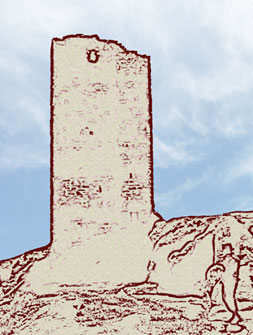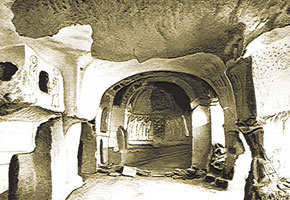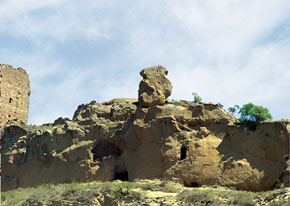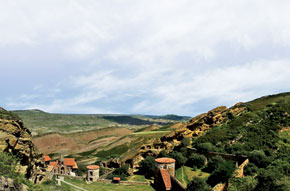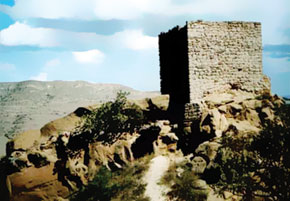Pages 86-90
by Yunis Nasibli
Origins
This complex is located in the Agstafa region of the Republic of Azerbaijan. At various periods in history it has included 17 monasteries and other religious sites cut into the rock on spurs of the bare mountains, dividing pools of the rivers Gabyrry and Kur and covering almost 25 km. By order of the President of the Republic of Azerbaijan dated 19 January 2007, the complex was declared a historical and architectural conversation area.
The founder of the complex and initiator of the monastic community is thought to have been David, the noted Christian figure, one of the so-called “13 Syrian fathers”. David lived in the area in the 530s-550s and his name went down in Georgian church records and historical essays with the attribute “Garejeli”, i.e. “alien, outsider, stranger”1. The environment surrounding this monastic complex and its branches is very poor - waterless mountain ridges and dry bare steppe. David and his fellows, Monophysite Syrians, persecuted within lands controlled by Dyophysite Byzantium, were propagators of Christianity among pagans and acted to reinforce the basics of Christianity among those inhabitants of the central part of the South Caucasus already converted to Christianity. According to church legends, David had originally lodged close to the Tbilisi fortress founded by the Sassanids, but then went to the foot of the mountain, known nowadays as “Holy David” or Mtasmind. He “built a cave on “the Sacred Mountain” and settled there. He “constructed a small church or, to be more precise, a chapel for divine services. After some time, he left for the mountains of Gareji, 57 versts from Tiflis (Tbilisi), where he established a cloister.”2
Schism
Over the centuries this whole area was subject to historical and cultural processes which often depended on the military and political, as well as the religious, manoeuvres of the great powers of the epochs - such as the Byzantine Empire and the Sassanid state. After the Council of Chalcedon, the Caucasian churches expressed, for the first time in common, their attitude towards the Christological polemic at the General Council of Dvin in 506: the Council accepted “The Henoticon” (482) of Zeno (450-491) and supported the conciliatory policy of the Byzantine emperors3. From the Council of Dvin in 506 to the middle of the 6th century, no direct testimony to the creed of the Caucasian churches can be found in any source. This may be an indirect indication that the position of the churches had not changed in essence throughout that time, or that one had not been issued by all the clergy of the church4.
During the same period Byzantium changed the church’s policy. The politics of Zeno and Anastasius, who reconciled the Dyophysites and the Monophysites (491-518) gradually developed into Pro-monophysite politics, however this situation did not¬ continue for long. Anastasius’ successors, Justin (518-527) and Justinian (527-565), wishing to win the support of the population of Constantinople and the clergy, the vast majority of whom were attached to the Orthodoxy, and also seeking support from the Holy See in Rome, openly and strongly opposed the Monophysites in Asia Minor and Syria. First of all, heretical dogmas were put outside the law, their followers were forbidden to have their own ecclesiastical organisation and hierarchy, or to perform rites of worship, the law allowed intervention into their private lives and, strictly limited their rights of succession and disposal of property. In 519, 54 bishops who refused to accept the dogmas and rituals of Dyophysitism were expelled from the empire. The response to persecution was a mass flight by followers of heterodox dogmas, especially into the possessions of Byzantium’s constant enemy, Sassanid Iran. Shahenshah Khosrov Anushirvan (531-579) allowed opponents of Byzantine Orthodoxy, the representatives of the Nestorian and Monophysitic currents of Christianity, to build churches and monasteries in outlying areas of the empire.
In the middle of the 6th century, Sassanid Iran tried to create a united Monophysite ¬camp in the Caucasus. At the Local Councils of 551-553 the Armenian church, with the assistance of representatives of the Syrian church, officially declared Monophysitism to be its ideological choice and defined a liturgy corresponding to the dogmas. Georgia (Kartli) and Albania did not convoke similar councils. In search of a balance between Byzantium and Iran they, possibly, did not reject the positions of the Dyophysitic Council of Chalcedon, but also did not follow a path of active Antimonophysitism. According to the written sources, a strong wave of Nestorianism in Albania even led to a Nestorian episcopacy in the city of Paytakaran (close to the present Beylagan). The names of some of the bishops are known from synodal documents of the 6th century.
The Albanian Catholicos Abas, seeking a compromise in the continuing struggle between creeds ¬(551-596) retained a moderate Chalcedonian position and accepted the formula of patriarch Peter of Antioch in Syria (with breaks 469-489). According to the “History of Albania”, the Chalcedonian monks Foma (Thomas), Elia, Biot, Ibas and others, who were compelled to leave the country, acted against such innovation. Moses Kalankatuysky stresses that Catholicos Abas “so restored the peace in the brotherhood, by the holy mercy of the Sovereign Lord.”5 The Albanian monk-scientists who did not obey Abas’ innovation moved, over a period of time, to Albanian monasteries in Jerusalem and other centres of Dyophysitism.
St. David Garejeli
Such were the basic historical conditions in which David and the other “Syrian fathers” were active. According to Eastern Christian tradition, 13 Syrian priests, including David, settled in sparsely populated places in the central part of the South Caucasus. Owing to the activities of these “Syrian fathers”, David, Stepanos, Piros and Abibos were able to establish Christian religious-educational temples, churches and cave cells in western Albania. The asceticism of their predecessors and associates such as John, Zeno, Anthony Thaddaeus, Jesse, Isidore, Joseph, Michael and Shio in neighbouring areas, were instrumental in the preservation and survival of Christianity here during total political domination and religious and cultural pressure from the Persians – who were fire worshippers. David, together with a pupil, Lucian, settled in Kambisen, historically part of Caucasian Albania, ruled by the marzban, the local Sassanid chief. His work did not contradict official policy, which supported the Monophysite current of Christianity. The general similarity of the severe and torrid nature of the Keshikchidagh mountain terrain – ancient writers had described its desert and arid climate - with that of David’s initial monastic experience in Mesopotamia, probably influenced the choice of location. Historians noted that a pass from Georgian Iberia to Albania was located in Kambisen, a rough, stony and waterless district. For example, according to Plutarch (Comparative biographies, XXXV) the Roman commander Pompey, having received news of new actions by the Albanians in 65 BC, turned back in irritation and anger, hardly managing to cross the river Kur and, as a long and painful trek across waterless steppe (the present Jeyranchel plain) lay ahead, he ordered ten thousand wineskins to be filled with water.
Cup-shaped pits hollowed out in rocks, which have remained to this day, are evidence of arid lands. The monks collected rain water in them, which they learned to store and make drinkable. It is known that Syrian monastic asceticism, with its severe trials of the flesh and refusal of earthly blessings - an existence half-starved in the hope of achieving purity of spirit and learning secrets from God - received widespread praise as far back as the early Middle Ages.
In view of the fact that the rocks of Keshikchidagh go back to the most ancient of geological periods and are prone to crumble and disappear, access to many of the dilapidated or even comparatively whole relics, caves, monastic cells, churches and auxiliary constructions is very complicated. The cells of Saint David, located on the northern slope of the mountain, are thought to be the main monastery. Even during David’s lifetime his monastic cloister branched out into the monasteries of Dodo and John the Baptist. Monasteries branched off from them in all directions over the centuries. At times the monasteries held one thousand members. Somewhat later, with the disintegration of the structure of the Albanian church and the strengthening of the Albanian catholicate in its former dioceses, the Georgian and Armenian churches had increasing influence from the 10th century onwards. Thus, Bishop Ninotsmindsky, who had hierarchical responsibility for the Gareji deserts, was assigned the specific title “Archimandrite of 12 deserts”. By the 12th century, 12 monasteries had already been established in this area and the foundations of another 5 were laid at the turn of 12th and 13th centuries, including a monastery named Bertubani, “Cloister of the Elders” (founded 1208-1209).
One more monastery – Chichkhikturi - as well as the Revival Church, is also located within Azerbaijan. There are also more than 100 caves on the southern slope of the mountain; they were used as cells by the monks.
The archaeology
All monuments, towers, cells and other monastic constructions, experience changes in use over time and can reveal much. For example, according to archaeologist Mansur Mansurov, one of the temples on Keshikchidagh, built from large, regular, rough-finished and time-corroded stones with an entrance door on the eastern side, is clearly influenced by the Albanian style of construction. Mansurov believes that the Sun and the Moon were represented on the lintel stones over the door; they are often seen over the entrance to Albanian temples6. The same was also noticed by Academician G.Chubinashvili, who organised a scientific expedition to the cave monastic complexes in the late 1920s and who wrote that “some cells with more regular geometric forms, close to those listed, as well as in other places, give the impression of being rebuilt from more ancient constructions”7.
Archaeological, epigraphic and fine art research into the accessible parts of the Keshikchidagh monastic complex continued in the 1960s and 1970s and revealed extensive materials confirming “double-layered” paintings and wall inscriptions in cave churches and other constructions in the complex8. It is clear that it is impossible to attribute the monastic complex to any single historical and cultural community until the turn of the 11th and 12th centuries. At the end of the 9th century - a period when the Caliphate’s influence was weaker - in northwest Albania, where the ethnic consciousness of the remaining Christian population was still preserved, there arose first a local feudal princedom (melikstvo) – and then, at the end of the 10th century, it was declared to be an Albanian kingdom9.
At the same time, it would be inappropriate to deny the affinity between the Albanian and East Georgian churches during certain historical periods. Thus Z. Aleksidze concludes that “documents of “the Book of Messages” show unambiguously that Albanian church representatives held the same view as the Georgians... during the 607-609 polemic with leading Armenian clerics about definitions of the Council of Chalcedon”; and this merits attention. Thus, Albanian texts appeared in a Georgian (Dyophysite) context. “Detection of Albanian texts in a Georgian environment, on the one hand confirms the¬ existence of such unity; on the other hand, this unity dates the bottom layer of the Georgian-Albanian palimpsest”10. We are more inclined to relate the second part of the quotation cited to the post-Caliphate period, to the final stage of the existence of the Sheki princedom (“the Albanian kingdom”).
These monastic constructions and temples experienced many invasions throughout the late Middle Ages. In the 13th century they suffered significant damage at the hands of the Mongols. Although the David Gareji monastery is mentioned in the charter of protected properties, among other possessions of the Mtskhetsky Catholicate at the end of the 14th century (1392)11, nevertheless neither the monastery nor the church had parishes any longer. However, in the 15th and 16th centuries there was probably a revival of monastic and religious life there as, according to the sources, monks were killed when the armies of Shah Abbas I took the field against rebels in the early 17th century. At the end of the same century, first Tsar Teymuraz, and then Tsar Archil took steps to restore monastic life in the David-Gareji cells, and this became possible with the assignment of Onuphrius Gareji as father superior; he received not only a pseudonym, but also the former monastic lands thanks to his activities. In the 18th century, frequent attacks by mountain tribes of the North Caucasus undermined development of the monastic complex and, in the first half the 19th century, the community practically died out, just a few elders remaining in the John the Baptist monastery.
About the author: Yunis M.Nasibli is an associate of the “History of Azerbaijan” Department of Baku State University, and vice-president of the Centre for Caucasian research.
1 See: Explanatory dictionary of the Georgian language, Tbilisi, 1986, p.128
2 Historical monuments and attractions of the city. (On Бегичеву).// Tiflis (Tbilisi) and its surroundings. 1913, p.5.
3 See: Zaza Aleksidze. Materials on the history of the Dvin Council of 506// “Vestnik” Academy of Sciences of the GSSR. Series ¬on history, archaeology, ethnography and the history of arts, 1973, № 3. p. 145-166 (in Georgian).
4 See: Zaza Aleksidze. Formation of national churches in the Caucasus//”Caucasus and globalisation”. Magazine of sociopolitical and economic research. 2008, volume 2, release 3, p. 112
5. Moses Kalankatuysky. History of the Country of Aluank. Translation from the Old Armenian language, foreword and comments¬ by Sh.I.Smbatyan. Yerevan, 1984. p. 74.
6. M.Farajullayeva. A snail on a slopе.// Newspaper “Zerkalo” (Mirror), 07.02.2004.
7. G.N.Chubinashvili. The David-Gareji Cave Monasteries. Sketch on the history of the art of Georgia. Tbilisi, 1948, p.36.
8. G.Gaprindashvili. Inscription of 1089 from “Chariton Cave” of the Gareji monastery. /// “Izvestiya” Academy of Sciences of the GSSR. Series of history, archaeology and ethnography, 1976, № 2, p.177-186.
9. “History of Albania”, p.273; History of Azerbaijan. Volume II (from the 3rd century to the first quarter of the 13th century). Baku, 1998, p. 325-326.
10. Zaza Aleksidze. Formation of national churches in the Caucasus, p. 115.
11. See: Georgian documents from the 9th-15th centuries, with translation and comments by S.S.Kakabadze. М, 1982, p.19
by Yunis Nasibli
Origins
This complex is located in the Agstafa region of the Republic of Azerbaijan. At various periods in history it has included 17 monasteries and other religious sites cut into the rock on spurs of the bare mountains, dividing pools of the rivers Gabyrry and Kur and covering almost 25 km. By order of the President of the Republic of Azerbaijan dated 19 January 2007, the complex was declared a historical and architectural conversation area.
The founder of the complex and initiator of the monastic community is thought to have been David, the noted Christian figure, one of the so-called “13 Syrian fathers”. David lived in the area in the 530s-550s and his name went down in Georgian church records and historical essays with the attribute “Garejeli”, i.e. “alien, outsider, stranger”1. The environment surrounding this monastic complex and its branches is very poor - waterless mountain ridges and dry bare steppe. David and his fellows, Monophysite Syrians, persecuted within lands controlled by Dyophysite Byzantium, were propagators of Christianity among pagans and acted to reinforce the basics of Christianity among those inhabitants of the central part of the South Caucasus already converted to Christianity. According to church legends, David had originally lodged close to the Tbilisi fortress founded by the Sassanids, but then went to the foot of the mountain, known nowadays as “Holy David” or Mtasmind. He “built a cave on “the Sacred Mountain” and settled there. He “constructed a small church or, to be more precise, a chapel for divine services. After some time, he left for the mountains of Gareji, 57 versts from Tiflis (Tbilisi), where he established a cloister.”2
Schism
Over the centuries this whole area was subject to historical and cultural processes which often depended on the military and political, as well as the religious, manoeuvres of the great powers of the epochs - such as the Byzantine Empire and the Sassanid state. After the Council of Chalcedon, the Caucasian churches expressed, for the first time in common, their attitude towards the Christological polemic at the General Council of Dvin in 506: the Council accepted “The Henoticon” (482) of Zeno (450-491) and supported the conciliatory policy of the Byzantine emperors3. From the Council of Dvin in 506 to the middle of the 6th century, no direct testimony to the creed of the Caucasian churches can be found in any source. This may be an indirect indication that the position of the churches had not changed in essence throughout that time, or that one had not been issued by all the clergy of the church4.
During the same period Byzantium changed the church’s policy. The politics of Zeno and Anastasius, who reconciled the Dyophysites and the Monophysites (491-518) gradually developed into Pro-monophysite politics, however this situation did not¬ continue for long. Anastasius’ successors, Justin (518-527) and Justinian (527-565), wishing to win the support of the population of Constantinople and the clergy, the vast majority of whom were attached to the Orthodoxy, and also seeking support from the Holy See in Rome, openly and strongly opposed the Monophysites in Asia Minor and Syria. First of all, heretical dogmas were put outside the law, their followers were forbidden to have their own ecclesiastical organisation and hierarchy, or to perform rites of worship, the law allowed intervention into their private lives and, strictly limited their rights of succession and disposal of property. In 519, 54 bishops who refused to accept the dogmas and rituals of Dyophysitism were expelled from the empire. The response to persecution was a mass flight by followers of heterodox dogmas, especially into the possessions of Byzantium’s constant enemy, Sassanid Iran. Shahenshah Khosrov Anushirvan (531-579) allowed opponents of Byzantine Orthodoxy, the representatives of the Nestorian and Monophysitic currents of Christianity, to build churches and monasteries in outlying areas of the empire.
In the middle of the 6th century, Sassanid Iran tried to create a united Monophysite ¬camp in the Caucasus. At the Local Councils of 551-553 the Armenian church, with the assistance of representatives of the Syrian church, officially declared Monophysitism to be its ideological choice and defined a liturgy corresponding to the dogmas. Georgia (Kartli) and Albania did not convoke similar councils. In search of a balance between Byzantium and Iran they, possibly, did not reject the positions of the Dyophysitic Council of Chalcedon, but also did not follow a path of active Antimonophysitism. According to the written sources, a strong wave of Nestorianism in Albania even led to a Nestorian episcopacy in the city of Paytakaran (close to the present Beylagan). The names of some of the bishops are known from synodal documents of the 6th century.
The Albanian Catholicos Abas, seeking a compromise in the continuing struggle between creeds ¬(551-596) retained a moderate Chalcedonian position and accepted the formula of patriarch Peter of Antioch in Syria (with breaks 469-489). According to the “History of Albania”, the Chalcedonian monks Foma (Thomas), Elia, Biot, Ibas and others, who were compelled to leave the country, acted against such innovation. Moses Kalankatuysky stresses that Catholicos Abas “so restored the peace in the brotherhood, by the holy mercy of the Sovereign Lord.”5 The Albanian monk-scientists who did not obey Abas’ innovation moved, over a period of time, to Albanian monasteries in Jerusalem and other centres of Dyophysitism.
St. David Garejeli
Such were the basic historical conditions in which David and the other “Syrian fathers” were active. According to Eastern Christian tradition, 13 Syrian priests, including David, settled in sparsely populated places in the central part of the South Caucasus. Owing to the activities of these “Syrian fathers”, David, Stepanos, Piros and Abibos were able to establish Christian religious-educational temples, churches and cave cells in western Albania. The asceticism of their predecessors and associates such as John, Zeno, Anthony Thaddaeus, Jesse, Isidore, Joseph, Michael and Shio in neighbouring areas, were instrumental in the preservation and survival of Christianity here during total political domination and religious and cultural pressure from the Persians – who were fire worshippers. David, together with a pupil, Lucian, settled in Kambisen, historically part of Caucasian Albania, ruled by the marzban, the local Sassanid chief. His work did not contradict official policy, which supported the Monophysite current of Christianity. The general similarity of the severe and torrid nature of the Keshikchidagh mountain terrain – ancient writers had described its desert and arid climate - with that of David’s initial monastic experience in Mesopotamia, probably influenced the choice of location. Historians noted that a pass from Georgian Iberia to Albania was located in Kambisen, a rough, stony and waterless district. For example, according to Plutarch (Comparative biographies, XXXV) the Roman commander Pompey, having received news of new actions by the Albanians in 65 BC, turned back in irritation and anger, hardly managing to cross the river Kur and, as a long and painful trek across waterless steppe (the present Jeyranchel plain) lay ahead, he ordered ten thousand wineskins to be filled with water.
Cup-shaped pits hollowed out in rocks, which have remained to this day, are evidence of arid lands. The monks collected rain water in them, which they learned to store and make drinkable. It is known that Syrian monastic asceticism, with its severe trials of the flesh and refusal of earthly blessings - an existence half-starved in the hope of achieving purity of spirit and learning secrets from God - received widespread praise as far back as the early Middle Ages.
In view of the fact that the rocks of Keshikchidagh go back to the most ancient of geological periods and are prone to crumble and disappear, access to many of the dilapidated or even comparatively whole relics, caves, monastic cells, churches and auxiliary constructions is very complicated. The cells of Saint David, located on the northern slope of the mountain, are thought to be the main monastery. Even during David’s lifetime his monastic cloister branched out into the monasteries of Dodo and John the Baptist. Monasteries branched off from them in all directions over the centuries. At times the monasteries held one thousand members. Somewhat later, with the disintegration of the structure of the Albanian church and the strengthening of the Albanian catholicate in its former dioceses, the Georgian and Armenian churches had increasing influence from the 10th century onwards. Thus, Bishop Ninotsmindsky, who had hierarchical responsibility for the Gareji deserts, was assigned the specific title “Archimandrite of 12 deserts”. By the 12th century, 12 monasteries had already been established in this area and the foundations of another 5 were laid at the turn of 12th and 13th centuries, including a monastery named Bertubani, “Cloister of the Elders” (founded 1208-1209).
One more monastery – Chichkhikturi - as well as the Revival Church, is also located within Azerbaijan. There are also more than 100 caves on the southern slope of the mountain; they were used as cells by the monks.
The archaeology
All monuments, towers, cells and other monastic constructions, experience changes in use over time and can reveal much. For example, according to archaeologist Mansur Mansurov, one of the temples on Keshikchidagh, built from large, regular, rough-finished and time-corroded stones with an entrance door on the eastern side, is clearly influenced by the Albanian style of construction. Mansurov believes that the Sun and the Moon were represented on the lintel stones over the door; they are often seen over the entrance to Albanian temples6. The same was also noticed by Academician G.Chubinashvili, who organised a scientific expedition to the cave monastic complexes in the late 1920s and who wrote that “some cells with more regular geometric forms, close to those listed, as well as in other places, give the impression of being rebuilt from more ancient constructions”7.
Archaeological, epigraphic and fine art research into the accessible parts of the Keshikchidagh monastic complex continued in the 1960s and 1970s and revealed extensive materials confirming “double-layered” paintings and wall inscriptions in cave churches and other constructions in the complex8. It is clear that it is impossible to attribute the monastic complex to any single historical and cultural community until the turn of the 11th and 12th centuries. At the end of the 9th century - a period when the Caliphate’s influence was weaker - in northwest Albania, where the ethnic consciousness of the remaining Christian population was still preserved, there arose first a local feudal princedom (melikstvo) – and then, at the end of the 10th century, it was declared to be an Albanian kingdom9.
At the same time, it would be inappropriate to deny the affinity between the Albanian and East Georgian churches during certain historical periods. Thus Z. Aleksidze concludes that “documents of “the Book of Messages” show unambiguously that Albanian church representatives held the same view as the Georgians... during the 607-609 polemic with leading Armenian clerics about definitions of the Council of Chalcedon”; and this merits attention. Thus, Albanian texts appeared in a Georgian (Dyophysite) context. “Detection of Albanian texts in a Georgian environment, on the one hand confirms the¬ existence of such unity; on the other hand, this unity dates the bottom layer of the Georgian-Albanian palimpsest”10. We are more inclined to relate the second part of the quotation cited to the post-Caliphate period, to the final stage of the existence of the Sheki princedom (“the Albanian kingdom”).
These monastic constructions and temples experienced many invasions throughout the late Middle Ages. In the 13th century they suffered significant damage at the hands of the Mongols. Although the David Gareji monastery is mentioned in the charter of protected properties, among other possessions of the Mtskhetsky Catholicate at the end of the 14th century (1392)11, nevertheless neither the monastery nor the church had parishes any longer. However, in the 15th and 16th centuries there was probably a revival of monastic and religious life there as, according to the sources, monks were killed when the armies of Shah Abbas I took the field against rebels in the early 17th century. At the end of the same century, first Tsar Teymuraz, and then Tsar Archil took steps to restore monastic life in the David-Gareji cells, and this became possible with the assignment of Onuphrius Gareji as father superior; he received not only a pseudonym, but also the former monastic lands thanks to his activities. In the 18th century, frequent attacks by mountain tribes of the North Caucasus undermined development of the monastic complex and, in the first half the 19th century, the community practically died out, just a few elders remaining in the John the Baptist monastery.
About the author: Yunis M.Nasibli is an associate of the “History of Azerbaijan” Department of Baku State University, and vice-president of the Centre for Caucasian research.
1 See: Explanatory dictionary of the Georgian language, Tbilisi, 1986, p.128
2 Historical monuments and attractions of the city. (On Бегичеву).// Tiflis (Tbilisi) and its surroundings. 1913, p.5.
3 See: Zaza Aleksidze. Materials on the history of the Dvin Council of 506// “Vestnik” Academy of Sciences of the GSSR. Series ¬on history, archaeology, ethnography and the history of arts, 1973, № 3. p. 145-166 (in Georgian).
4 See: Zaza Aleksidze. Formation of national churches in the Caucasus//”Caucasus and globalisation”. Magazine of sociopolitical and economic research. 2008, volume 2, release 3, p. 112
5. Moses Kalankatuysky. History of the Country of Aluank. Translation from the Old Armenian language, foreword and comments¬ by Sh.I.Smbatyan. Yerevan, 1984. p. 74.
6. M.Farajullayeva. A snail on a slopе.// Newspaper “Zerkalo” (Mirror), 07.02.2004.
7. G.N.Chubinashvili. The David-Gareji Cave Monasteries. Sketch on the history of the art of Georgia. Tbilisi, 1948, p.36.
8. G.Gaprindashvili. Inscription of 1089 from “Chariton Cave” of the Gareji monastery. /// “Izvestiya” Academy of Sciences of the GSSR. Series of history, archaeology and ethnography, 1976, № 2, p.177-186.
9. “History of Albania”, p.273; History of Azerbaijan. Volume II (from the 3rd century to the first quarter of the 13th century). Baku, 1998, p. 325-326.
10. Zaza Aleksidze. Formation of national churches in the Caucasus, p. 115.
11. See: Georgian documents from the 9th-15th centuries, with translation and comments by S.S.Kakabadze. М, 1982, p.19
